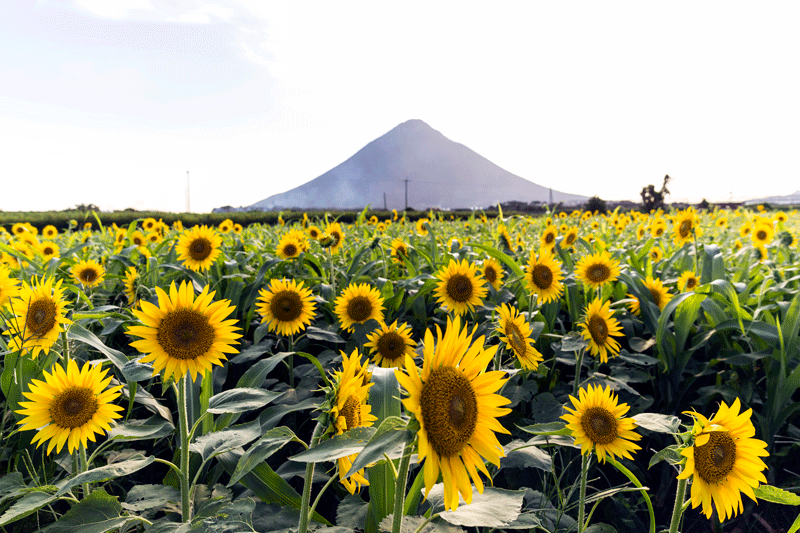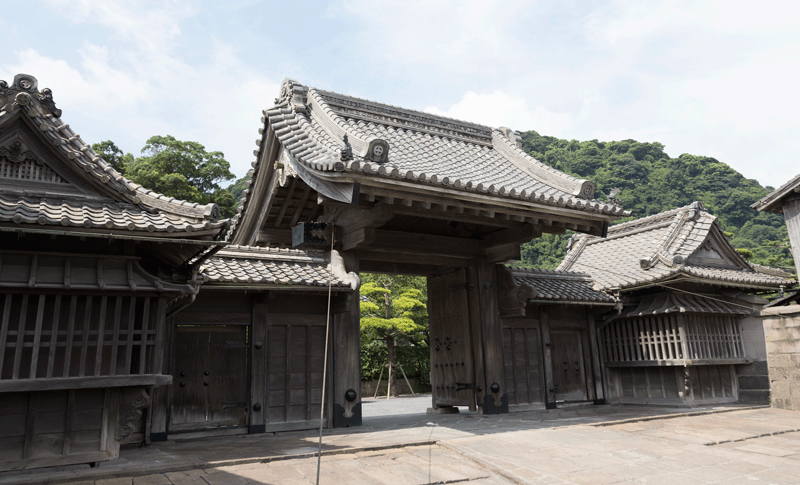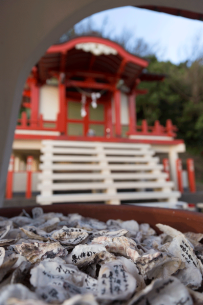Steeped in history and surrounded by peerless natural beauty, Kagoshima Prefecture is a land where the living is truly easy.
Peach skies overhead, a warm ocean breeze, and the smells of nature are stark reminders that Kagoshima is vastly different from Tokyo. Still fondly referred to as Satsuma, the most southern part of Kyushu has a great deal to offer visitors. Often, people think of Japan and imagine Kyoto or Shibuya, though there is a vast world of Japan yet to be discovered. Here, life is different from the more popular destinations. Life is slower, life is adventurous, life is natural, life is humble and human. Tourists are less likely to frequent the area; thus, more “hotspots” are preserved and more honest. There is purity in the attitude of the people in Kagoshima, who welcome anyone and everyone.
Centuries ago, Satsuma and Edo weren’t quite on the friendliest of terms. Cordial and abiding, Japan was quiet for centuries, especially while its international ports were closed and Edo kept the doors shut on the world from 1450 to 1770.
Satsuma, however, remained open. Trading among China, Korea, Russia and Spain was a regular affair. Satsuma had its own currency to conceal trading from Edo, so monetary exchanges couldn’t be tracked. Weapons from the United States, gifts from Abraham Lincoln after the Civil War, made it into Satsuma. Pottery made it out of Satsuma, and across the world to France and England.
The subsequent leadership of Saigo Takamori, heralded as one of the most forward-thinking leaders of Japan (and one of the tallest), helped Satsuma grow and develop its own strength to defend itself, and Japan. The independence and disobedience towards Edo led to the eventual and unavoidable Meiji Restoration of 1868, which thrust Japan into the modern and global world.
Today, evidence of this globalism and unique drive is exhibited by the people. Everyone possesses their own creative purpose, and has their own personal pride that keeps them upright. Kagoshima is a place of beauty; a place of healing, history, and exploring. Though it has evolved subtly, much of “old” Satsuma perseveres throughout the region to this day. Make Kagoshima your next destination, and see, for yourself, the place that helped to guide and shape present-day Japan.
Sakurajima
Sakurajima is perhaps one of the sites people may be most familiar with when they think of Kagoshima. The volcano on the island is famously known to react and erupt on an almost daily basis—over the course of the previous summer, it was known to have erupted over 600 times. Not every day is so lucky; often, the summit may be enveloped in clouds or haze, or the eruptions so small they go undetected from across the bay. The largest eruption in Japan was by Sakurajima, in 1914—it spilled enough lava to connect it to the nearby peninsula. Around the city, you can find “Giant Sakurajima Daikon,” which were harvested on the island near the chain of hot springs in the vicinity. Be wary of the delicate, flowery name it was given, and check the schedule daily for a warning, in case of an evacuation notice. You can view it and the city from a higher point up at Shiroyama Observatory.
Sengan-en
Across the bay from Sakurajima is one of the most important parks in Japan: Sengan-en. Created in 1658 primarily as the grounds for a villa under Lord Shimadzu Mitsuhisa, it is preserved today as a garden for visitors to learn about the history of Satsuma and see a number of recreated tools, weapons, buildings, and the like. Many historical plant varieties thrive today, cared for by volunteers and historians. A museum with a café on-site serves Satsuma history with a side of sweet potatoes and teas. The gardens themselves are expansive, and the natural jungles played important roles in centuries’ worth of battles. There is a bus stop directly outside the gardens, just ten minutes from downtown Kagoshima City.
Mt. Kaimon
Considered to be the “Satsuma Fuji,” Mt. Kaimon rises prominently in the midst of Kagoshima’s “healthy lands,” where the soil is richest for farming, flowers grow wild, and the hot springs are the clearest and freshest. Mt. Kaimon is an icon of the south; residents will happily discuss the symmetry and beauty of the deep green mountain. It too is considered an active volcano, though its summit is preserved at a modest 924 meters. There are hiking restrictions; though there is no frost or snow, even in winter.
Cape Nagasaki
Cape Nagasaki marks the southernmost point of the Satsuma Peninsula. A small white lighthouse faces the open sea, guiding ships, which come from as close as Yakushima or as far away as Europe, into the bay. Right behind the lighthouse, up the slope of the Cape, is Ryugu Shrine. The bright red and orange colors of the shrine sharply contrast with the blue sea, where the god Ryugu is said to live. Shells replace traditional wooden mamori boards, and shrine-goers can write their wish and place it carefully into a wooden bucket nearby. The drive to the cape is quite scenic as well; it takes visitors around Mt. Kaimon, past wild sunflower fields, and is just down the street from the popular Flower Park Kagoshima.
Makurazaki City
Perhaps the most impressive part of Makurazaki City is not the beautiful scenery, or the delicious southern food, or the warm ocean beaches, but the smell. Makurazaki produces much of the fish flakes found in Japanese supermarkets—and yes, the smell of fish is strong in the air. It doesn’t take long to get used to, and the city holds a few gems for visitors. The roads run high in the mountains, and offer breathtaking views of the ocean. The vista has inspired countless works of art, particularly old Buddhist paintings. Even Hollywood used Makurazaki and the nearby mountains as a background during the production of the James Bond film “You Only Live Twice” in 1967. There is a marker visitors can find if they have a very good GPS system.
Getting There
There are about 30 flights per day between Tokyo (Narita or Haneda) and Kagoshima, and travel time is about 1 hour and 45 minutes. You can go there by Shinkansen as well, but be prepared for a several-hour trip—best if part of a longer journey down south.
Sponsored Post
Updated On December 26, 2022












